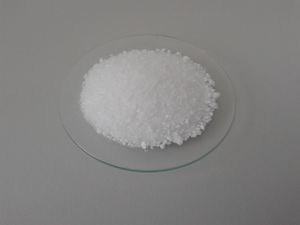Zinc acetate
 Sample of zinc acetate dihydrate
| |
| Names | |
|---|---|
| IUPAC name
Zinc acetate
| |
| Other names
Acetic acid, zinc salt
Acetic acid, zinc(II) salt Dicarbomethoxyzinc E650 Zinc(II) acetate Zinc diacetate | |
| Properties | |
| Zn(CH3COO)2 (anhydrous) Zn(CH3COO)2·2 H2O (dihydrate) | |
| Molar mass | 183.48 g/mol (anhydrous) 219.50 g/mol (dihydrate) |
| Appearance | Colorless crystalline solid |
| Odor | Faint acetic |
| Density | 1.735 g/cm3 (dihydrate) |
| Melting point | 100 °C (212 °F; 373 K) (dihydrate, decomposition) 237 °C (459 °F; 510 K) (anhydrous, decomposition) |
| Boiling point | Decomposes |
| dihydrate: 43 g/100 ml (20 °C) | |
| Solubility | Slightly soluble in acetic acid, acetic anhydride, acetyl chloride, acetone, aniline, benzonitrile, butanol, dimethyl sulfate, dimethylformamide, dioxane, epichlorohydrin, ethanol, methanol, methyl propionate, pyridine, THF Almost insoluble in liq. ammonia Insoluble in bromoacetic acid, liq. SO2, toluene, xylene |
| Solubility in acetic acid | 0.293566 g/cm3 (at 25 °C) |
| Solubility in ethanol | 0.495393 g/cm3 (at 25 °C) |
| Hazards | |
| Safety data sheet | Alfa Aesar (anydrous) FisherScientific (dihydrate) |
| Related compounds | |
| Related compounds
|
Copper(II) acetate Cadmium acetate |
| Except where otherwise noted, data are given for materials in their standard state (at 25 °C [77 °F], 100 kPa). | |
| Infobox references | |
Zinc acetate is a chemical compound with the formula Zn(CH3COO)2 the acetic acid salt of zinc, more commonly encountered as dihydrate, Zn(CH3COO)2·2 H2O.
It is also used as food additive, E650.
Contents
Properties
Chemical
Zinc acetate reacts with bases to form insoluble zinc hydroxide:
- Zn(CH3COO)2 + 2 NaOH → 2 CH3COONa + Zn(OH)2
According to one paper, pyrolysis of anhydrous zinc acetate (at reduced pressure) should yield acetic anhydride and leave behind basic zinc acetate:
- 2 Zn(AcO)2 → Zn4(AcO)6 + Ac2O
So far this route has not been confirmed.
Physical
Zinc acetate is a solid crystalline, soluble in water. Its anhydrous form is hygroscopic and quickly turns into the dihydrate form upon standing in open air. It has a weak acetic smell.
Availability
Zinc acetate is available as food supplements and can be purchased online. To obtain the pure compound, you will have to dissolve the product in water and recrystallize it from the solution.
Anhydrous zinc acetate can be prepared by heating the dihydrate or refluxing it with toluene and collecting the water with a Dean-Stark apparatus.
Higher purity Zn(AcO)2 can be purchased from chemical suppliers.
Preparation
Zinc acetate can be prepared by adding zinc metal or zinc oxide to acetic acid.
- 2 CH3COOH + Zn → Zn(CH3COO)2 + H2
- 2 CH3COOH + ZnO → Zn(CH3COO)2 + H2O
Vinegar can also be used as cheap source acetic acid. After all the zinc has dissolved, the solution is concentrated and cooled to crystallize solid zinc acetate dihydrate. If vinegar was used, organic residue from the vinegar will be trapped in the zinc acetate crystals. To remove the impurities, crush the resulting crystals and wash them thoroughly with an organic solvent. Multiple recrystallizations might be required to remove all the impurities.
If anhydrous zinc acetate is desired, you can dry the zinc acetate dihydrate by refluxing it with toluene, and using a Dean-Stark apparatus to separate the water.
Projects
- Grow crystals
- Make zinc metal
- Make glacial acetic acid
- Synthesis of acetic anhydride
Handling
Safety
Zinc acetate is slightly irritant due to the acetic acid resulting from hydrolysis, though this is not a problem when handling the compound.
Storage
Zinc acetate should be stored in closed bottles, away from moisture and acids, in a well ventilated place.
Anhydrous zinc acetate should be kept in air-tight containers.
Disposal
No special disposal is required for zinc acetate, though it's best to dilute it strongly if you want to pour it down the drain. Alternatively, you can precipitate zinc hydroxide/oxide by adding an alkali to a solution of zinc acetate.